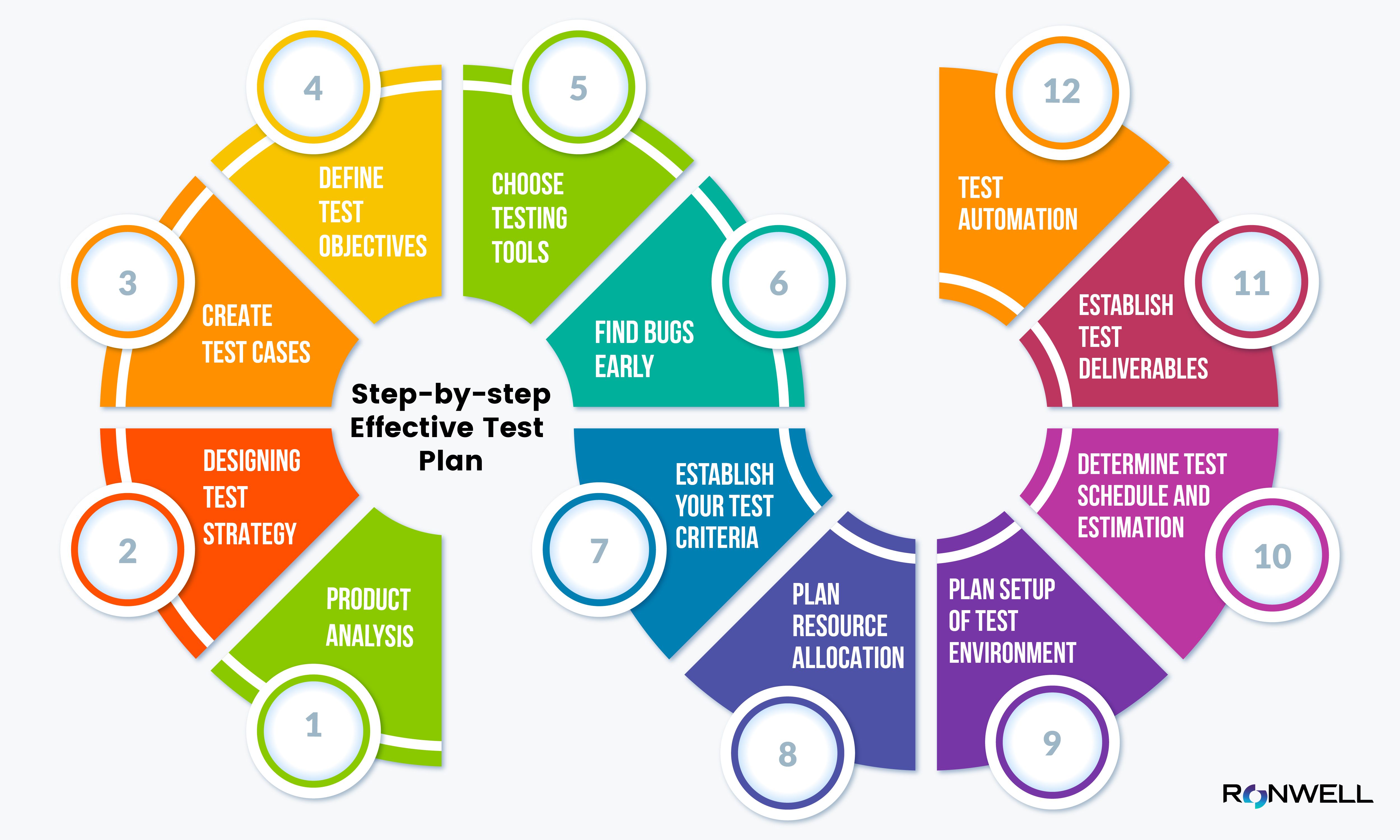

Our Services
Test Automation ServicesAI & Machine LearningBlockchainCRM ConsultingData Science & EngineeringDevOpsDigital MarketingDigital TransformationEmbedded Software DevelopmentERP Consulting ServicesManaged IT ServicesMergers & Acquisitions AdvisoryQA And Testing ServicesRobotic Process Automation SAP Consulting DevelopmentSoftware and Application DevelopmentSQL ConsultingStrategy ConsultingSustainability
- Contact Us
Our Services
- Test Automation Services
- AI & Machine Learning
- Blockchain
- CRM Consulting
- Data Science & Engineering
- DevOps
- Digital Marketing
- Digital Transformation
- Embedded Software Development
- ERP Consulting Services
- Managed IT Services
- Mergers & Acquisitions Advisory
- QA And Testing Services
- Robotic Process Automation
- SAP Consulting Development
- Software and Application Development
- SQL Consulting
- Strategy Consulting
- Sustainability
Insight
Company
Industries
- Contact Us

Test Plan: The A-to-Z Guide
You will learn more about Test Planning as well as how to write effective test plans step-by-step. A detailed test plan document is also available for download.
- insight
- /
- blog
- /
- test-plan
Building a software test plan is a cornerstone of the software testing process. As life cycle procedures have been simplified via methodologies like Agile and DevOps, the need to create test plans and other types of test documentation has been diminished or discarded entirely. A test plan has a lot of value and can be helpful for all projects, independent of a lifetime. Therefore, it's sad that this is the case.
Extra blog: Is Test Automation A Good Career Choice In 2023?
A test plan is helpful in making sure sufficient resources are available to accomplish the goals of the test, regardless of the lifecycle method being used.
Even in testing methods like "exploratory testing," test charters are used to describe the focus of a testing period, who will do the tests, and how much time will be spent on them.
Planning is essential for everything in life and business. A venture that lacks a project strategy is sure to fail. Unfortunately, test planning is often disregarded while being crucial.
Remember that the effectiveness of a test strategy depends on its actual execution. If you put in the time and energy to draft a test plan, stick to it, modifying it as necessary. You can also read our article to learn more about Test Automation Strategy: Importance, Benefits & Example.
It is common knowledge that changes must be made to any plan after work has begun. Not giving up, but rather making adjustments so that the plan can work in practice. This is particularly important while developing test strategies.
In this article, you will find the types and components of a test plan, and learn how to write an effective test plan with a downloadable test plan example.

What is a Test Plan?
Test plans are like project plans for the testing process.
In other words, the test plan describes the procedures to be followed during testing on a certain level, such as system testing or user acceptability testing, or for a specific kind of testing, such as performance testing or security testing.
Think of the Test Plan (also called a QA Test Plan) as the blueprint or road map for your testing strategy.
So What Does QA Stand For Software?
It lists;
- the goals of testing: what you want to check and/or validate
- the scope of testing: what will be tested and what won't be tested
- a general and sometimes detailed schedule of the tasks you want to do: how and when you are testing
The risks that are expected in the project should be written down in the test plan, along with their levels, so that testing can be done in order of risk.
The part of a test plan which can be the most important is the list of resources. Human resources include the people who work on the test, while technical resources include the test environment, test tools, and test data.
The goal of creating a test plan is to define the scope, complexity, and schedule of the testing that will be done. The test plan can also include the software tester's required tools.
The following details are often included in a test plan:
1. We need to define our end goal for this testing process.
2. A detailed description of the testing procedure.
3. The features and components or applications to be tested.
4 Comprehensive strategies for allocating time and other resources to testers and developers throughout the testing process.
Need more information about the Top 20 Automation Testing Tools?
Types of a Test Plan
Here are the three types of a test plan;
Master Test Plan
The master test plan is an extensive document that details the management and organization of testing at all levels.
It gives an overview of the important decisions that were made, the strategies that were used, and the testing that was done for the project. Each required test is detailed in the master test plan. Test coverage, connections between different test levels and code tasks, strategies for running tests, and so on.
Test Phase Plan
The test phase plan goes into detail about the testing plans that must be used for each test level or sometimes test type.
Most of the time, the level test plan has more information about the levels that are listed in the master testing plan. They would give information that isn't in the master plan, like the testing schedule, benchmarks, activities, templates, and so on.
To learn more about test types, check: What is Automation Testing? Types, Examples, Process.
Specific Test Plans
Specific testing plans include performance and security testing plans.
For example, performance testing is a type of software testing that looks at how a system responds and works when given a certain amount of work. Security testing is a type of software testing that tries to find out where a system is weak and if its data and resources are safe from hackers.
Components of a Test Plan
For detailed information about test automation frameworks!
Scope
Specifics the aims of the undertaking at hand. It also describes user scenarios that will be used in tests. If needed, the scope can list situations or issues that the project won't cover.
Scheduling
Provides test team with a timeline of when to expect findings to be ready by and when to expect them from them.
Resource Allocation
Tell us which test each tester will work on.
Environment
Describes what the test environment is, how it is set up, and when it is available.
Tools
Describes the tools that will be used for testing, issue reporting, and other important tasks.
Defect Management
Describes how bugs will be reported, who they will be sent to, and what each bug report must include. Should images, text logs, or videos of code errors be included when reporting them?
Risk Management
Describes the risks that can happen while testing software and the risks that the software itself can face if it is released without enough testing.
Exit Parameters
Information about when testing must stop. This part explains what the expected results of the QA operations are so that testers can compare the actual results to the expected ones.
How to Write an Effective Test Plan Step-by-Step
Here is an effective way to write a test plan example step by step:
1) Product Analysis
Before beginning to test a product, it is important to gather as much information as possible about the product, the customer, and the target audience. Ask inquiries about how it was created to find out about its intended use and how it works and to gather details that may assist you in comprehending its operation.
During this stage, you should try to answer the following questions:
- Who will purchase this product?
- What is the main reason for buying this?
- How does this product work?
- What are the details about the software and hardware?
At this stage, you should:
- Clients, designers, and developers should be interviewed.
- Check the paperwork for the product and the project
- Walk through the product.
You should look around this website and also read the documentation for the product. Reviewing the product documentation helps you learn how to use the website and all of its features. If you're unsure about something, you could talk to the customer, the developer, or the designer to find out more.
2) Designing Test Strategy
In software testing, creating a test plan begins with developing a test strategy. The Test Manager is responsible for creating the comprehensive document known as the Test Strategy. The test manager creates this document, which includes the following definitions:
- Goals for the project and a plan to get there.
- the time and money needed for testing.
Specifically, the documentation has to state out:
Define the Scope of Testing
Lists what will be tested and what won't be tested in terms of software (hardware, software, and middleware).
The testing's intended coverage should be established before any testing is performed. You should give it plenty of thought.
What is "in scope" is the set of system elements (hardware, software, middleware, etc.) that will be subjected to testing.
It is also important to clarify exactly what parts of the system will not be tested.
Setting the boundaries of your testing project is important for everyone involved. Having a targeted scope is beneficial.
Provide reliable, up-to-date information on the tests you're doing with everyone involved.
What to look for when choosing a test automation service provider?
Everyone involved in the project will know exactly what is and isn't being tested.
While planning a project, how do you decide how far to go?
The scope is established by -
- Needs of the consumer, identified
- Planned expenditures and required outputs of a project
- Expertise and ability of your testing group
- It is the time to clearly identify what will be tested and what will not.
Whole website functionality and user experience testing (in scope testing)
Stress, performance, and logical database tests, all of which are nonfunctional, are not scheduled for execution at this time. out of the question.
Type of Testing
Details of the planned evaluations for the project. Since different tests uncover different kinds of errors, this is essential.
A testing type is a standard way to test that tells you what the test result should be.
Each type of testing is designed to find a certain kind of product bug. Yet, the end objective of every kind of test is the same: “early discovery of all the problems before distributing the customer.”
Several kinds of testing have been developed to ensure the quality of software. There simply aren't enough people on your team to do every possible kind of test. The test manager is responsible for assigning importance to the various types of testing.
- What kinds of tests should be prioritized while inspecting a web app?
- Which kind of testing should be avoided to save money?
To learn more about testing types, read our article What is Automation Testing? Types, Examples, Process
Risks and Issues
This document details every potential threat to the product or company that might arise during testing, including insufficient time or resources, inept management, and inaccurate cost estimates.
Risk | Migitation |
Team members don't have the right skills to test websites. | Plan a training program to help your members improve their skills. |
Test Manager lacks management skills. | Management leadership development programs should be planned. |
It's hard to finish this project on time because the schedule is so tight. | Set the test priority for each activity in the test. |
When your employees don't work together, they don't get as much done. | Motivate your team members to do their best in their assigned tasks by showing them that you believe in them. |
Wrong budget estimate and cost overruns | Before beginning work, define the project's goals and constraints, devote much time and energy to planning, and monitor and evaluate progress often. |
Test Logistics
Identifies who will be doing the testing and what they can do. Also included here are the testing methods and timetable.
- Who will test?
- When will the test occur?
Who will test?
You might not know the exact names of the people who will test, but you can say what kind of testers they are.
To choose the right member for a certain task, you need to think about whether or not his skills are appropriate for the task and estimate how much the project will cost. If you choose the wrong person for the job, the project could fail or take longer than planned.
The best person to test software is one who has the following skills:
- Capability to comprehend the customer's perspective
- Need for quality to be high
- Good cooperation and attention to detail
In your project, the tester is the person who will be in responsible for the way the tests are run. Depending on how much money you have for the project, you can choose a tester who works for you or someone else.
Additional reading: 5 Failures in Test Automation: Best Practices for Dealing with Them
When does the test take place?
There has to be a correlation between what is being tested and what is being built.
3) Create Test Cases
Making test cases is one of the most important parts of making a software testing document.
For more, read our blog post How to Create Test Cases for Automated Tests? With Example
A test case is a documentation that lists the steps you take to test something. It should include details like
- What needs to be tested
- How will it be tested
- Who will do the tests?
- The expected results
Test Case Type | Description | Test Step | Expected Results | Status |
Usability Testing | Make sure all links are functioning properly | Have users click on various links on the page | Links will take the users to another web page according to the on-page URL. | Pass / Fail |
Functionality Testing | Area should accommodate up to 25 characters | Input up to 25 characters | All 25 characters in the request should be appropriate | Pass / Fail |
Security Testing | Verify password rules are functioning | Create a new password in accordance with the rules | The user’s password will be accepted if it adheres to the rules. | Pass / Fail |
4) Define Test Objectives
During this step, the goals and expected results of test execution are set.
Since the goal of all testing is to find as many problems as possible, the objects must:
A list of all the software's features, including how it works, how it looks, and how well it works, must be tested.
The target performance or standard against which all of the testable aspects of the program are measured. All future findings will be compared to this one.
We explained Automation Testing Goals And Objectives in our blog post, check it out.
5) Choose Testing Tools
You must ensure that you have the right software testing tool to carry out your testing tasks. These tools might take the form of software or hardware, such as specialized testing equipment.
Not every problem can be solved with a cookie-cutter approach, therefore, it's vital to choose the right tools for the task.
6) Find Bugs Early
Don't forget to include time in your plan to address any issues that may arise. As a result, you may catch software issues before they become major headaches and prohibitively costly to remedy. As a result, dealing with them is less difficult and costs less money.
Try out any safety features an app may have, make use of all of its functions, and look for any problems.
7) Establish Your Test Criteria
Test criteria can be defined as standards or rules that can be used to make a test procedure or test judgment. There are two different kinds of test criteria, which are:
Suspension Criteria
It specifies the standards for suspending all testing. For example, if members of the QA team find that 50% of all test cases failed, all testing is stopped until all of the bugs that have been found so far are fixed.
Test Plan Example: If your team members say that 50% of the test cases failed, you should stop testing until the development team fixes all of the failed cases.
Exit Criteria
It details what must be met for a certain testing phase to be considered successful. The target results of the test are the exit criteria, which must be met before moving on to the next phase of development.
- Run rate is the number of test cases that were run out of the total number of test cases in the test specification.
- The pass rate is the number of tests that passed divided by the number of tests that were run.
This data is contained in documents called “Test Metrics.”
- Unless a clear reason is given, the run rate has to be 100%.
- Pass rate depends on the size of the project, but a high pass rate is an objective to achieve.
Test Plan Example: The test runs have been completed by your team. They tell you the result of the test and want you to confirm that the Exit Criteria are met.
8) Plan Resource Allocation
Include a resource plan in your software testing document. This plan should list the number of people who will be needed for the testing process. This should say what each person's task is and what kind of training they need to do it well.
This part of test planning is where you decide how many resources the project will need (number of testers and equipment). This also helps test managers make a schedule and accurate estimate for the project.
System Resource
Here is a resource planning table that should be used for testing:
Resources | Descriptions
|
Server |
|
Testing Tools |
|
Network |
|
Computer |
|
Human Resource
Here is a table representing various members of your project team:
Member | Tasks |
Test Manager |
|
Tester |
|
Developer in Testing |
|
Test Administrator |
|
SQA members |
|
9) Plan Setup of Test Environment
So, what is the test environment? And how to set up a test environment?
A testing environment is a software and hardware setup against which the QA team will perform test cases. The test environment comprises a real business and user environment, as well as physical surroundings, such as an operating server and front-end environment.
Setting up the testing environment
Here, Test Team and Development Team must collaborate closely to complete the project.
You should ask the developer several questions to have a thorough understanding of the product under test. Here're some suggested inquiries. Obviously, you may ask additional questions if necessary.
- What is the maximum number of concurrent users this website can accommodate?
- What hardware and software do you need to install this website?
- Does the user's computer require a certain configuration to access the website?
10) Determine Test Schedule And Estimation
Consider the following scenario for the Test Estimation phase: Divide the whole project into manageable chunks and estimate each component separately.
Task | Members | Estimation |
Create the test specification | Test designer | 170 hour |
Perform test execution | Tester, Test administrator | 70 hour |
Test report | Tester | 10 hour |
Test delivery | Tester | 30 hour |
Total | 280 hour |
11) Establish Test Deliverables
The Test Deliverables document details everything from written materials to software to hardware that must be created and kept in order to carry out the testing process.
Each stage of the software development lifecycle has its own set of test deliverables.
Test deliverables before the testing phase |
|
Test deliverables during the testing |
|
Test deliverables after the testing cycle is over |
|
12) Test Automation
Software test automation could be a good idea if your software is very complicated and needs a lot of test cases. It specifies what parts of the process will be automated and what won't.
- It is considered to be in need of manual testing if there are several issues with the functionality.
- If the feature is tested frequently, it can be fully automated.
By automating the process, testers can do more in less time, which increases productivity and cuts the cost of testing by a large amount.
Check our blog article about Manual Testing vs. Automation Testing - What is the difference?
FAQs
What is the Difference Between a Test Strategy and a Test Plan?
A test plan is a document that outlines the scope, goals, approach, and main focus of a software testing project, while a test strategy is a set of rules that classify how to develop and run tests.
References
We Are Developers - How to Create a Test Plan for Software Testing
Knowledge Hut - Test Plan in Software Testing
Writer:

Halime Yılmaz
Content Marketing Specialist
16 min read
7 March 2023, Tuesday
Related Posts
Related Industries
Related Services










